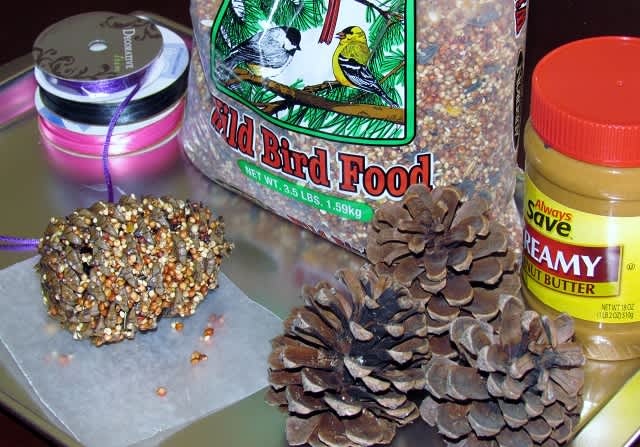A Great Outdoor Family Project: Make a Bird Feeder Together
Andy and Tami McDaniels 11.06.12

Inclement weather, breeding, and migration are taxing on birds and can change their food needs. According to the National Audubon Society, “More than 100 North American bird species supplement their natural diets with birdseed, suet, fruit, and nectar obtained from feeders.” Feeding birds benefits them and provides you and your family with opportunities to observe them up close. In addition, bird feeders make great gifts and festive yard decorations. Gather the family for an afternoon of fun. All ages will enjoy making these easy feeders.
Bread Cookies
What you will need:
- Cookie cutters in a variety of shapes
- 1 loaf of day-old bread (whole-grain or nutty varieties are most appealing to birds)
- 1 strand of raffia or ribbon
What you will do:
Use cookie cutters to press shapes out of the bread. Cut a small hole in the bread shape for hanging. Use ribbon or raffia to hang the treats outside around the yard.
Fruit Cups
What you will need:
- 1 grapefruit or orange
- 1 bag of birdseed
- 1 roll of string or ribbon
What you will do:
Cut the grapefruit or orange in half and hollow out the fruit with a spoon. Make a handle for hanging by poking 3 holes ½ inch from the edge, evenly distributed around the fruit. Thread string or ribbon through the holes, leaving approximately 1 foot for hanging. Tie a knot on each thread end to hold the handle in place. Fill with seed; then hang in yard.
 Dipped Cones
Dipped Cones
What you will need:
- 1 cup peanut butter
- 1 cup lard
- 1 bag of birdseed
- 10-12 pinecones
- 1 roll of ribbon or raffia
What you will do:
Place the peanut butter and lard in a microwave safe glass bowl. Microwave the combination on high for 30 second intervals until melted. Dip pinecones into the mixture, and then roll in a bowl of birdseed. Set the pinecones on wax paper to dry. After they have dried, tie lengths of raffia or ribbon around the cones. Hang the cones on trees.
Help keep the birds safe while feeding by positioning the feeders ten to twelve feet away from low shrubs or brush piles. Never place feeders in locations that could provide hiding places for cats and other predators. Provide fresh water for drinking and bathing nearby. For more tips on bird feeding, visit the National Wildlife Federation’s Garden for Wildlife page.
Once the birds start coming to your yard to feast, you will naturally want to learn about and identify them. You probably already know more about birds than you realize. Get Started Birding will help you take your knowledge to the next level with tips on choosing birder’s tools, taking notes, recognizing behavior, and listening for sounds and calls. Before you know it, you will be among the 48 million birdwatchers in America.


